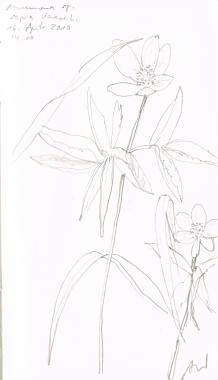anemona_2010_600dpi_ohne_rand.jpg
 Aliveness Explores the Poetic Space
Aliveness Explores the Poetic Space
Findings in the life sciences, particularly in biosemiotics, cognition research, and developmental biology, show that it is necessary to view organisms as goal-directed agents, who bring meaning and experience into the world as physically relevant powers.
“Biopoetics” pursues the idea that we can understand living beings through the aliveness we share with them. We are alive as are all organisms – and our existence follows the same principles which we know firsthand and from the inside, as it is through them we exist. these principles are alert concern, feeling, expressivity, connection-through-mutual transformation. they are the creative principles which guide poetic experience – hence the term “biopoetics”.
A General Theory of Conativity
The new perspective taken by biopoetics equals the shift in modern physics when scientists hundred years ago realized that any observer is entangled with the system being observed. Biological entanglement happens emotionally and experientially through sharing aliveness with and relating existentially to other living subjects.
Nature is self-expressive, mutually transformative, hence inter-imaginative. Nature ist the arena of poetic space. The whole of nature is inter-imagination and interpenetration. Aliveness is not health, aliveness is ongoing inter-imagination.
Enlivenment: Mutuality-in-Beauty
These poetic dimensions are not important because the world really is a cozy romantic and poetic place, but because we are parts and authors of an ongoing process of interdependent realization and transformation, in which we inter-imagine ourselves-as-others. We can truly think – and live– a reality of relations and entanglements only as a poetics.
This topics are further explored in the book:
Biopoetics. Towards a Theory of Life-as-Meaning. Berlin & New York, Springer, 2016.